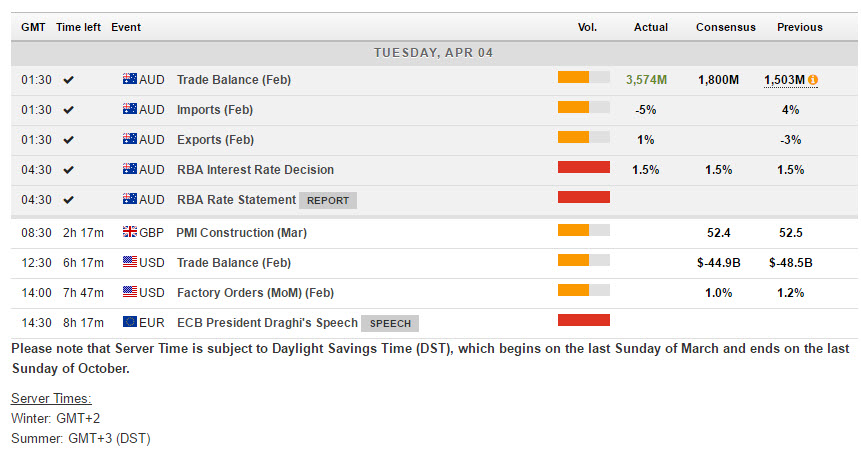FX News
European Outlook: Bund futures extended yesterday’s gains in opening trade, as DAX futures head south in tandem with U.S. futures after a largely negative session in Asia, where China and Taiwan remained closed for a holiday. Ongoing Yen strength is hitting exports and the RBA’s policy announcement, which left rates unchanged did little to cheer up the ASX. Investors continue to hold back ahead of the meeting between U.S. and China and FOMC and ECB minutes as well as U.S. jobs data at the end of the week. And with the European data calendar very quiet, Draghi’s speech is the only thing that could shake up things.
U.S. reports: revealed firm readings for March ISM and February construction spending, though we’re also seeing a 4% March drop in vehicle sales that trimmed our Q1 GDP growth forecast to 1.2% from 1.3%. For the ISM, there was only a small March drop to 57.2 from a 30-month high of 57.7 in February, and the jobs index surged to a 6-year high of 58.9 from 54.2. Robust producer sentiment readings is allowing the ISM-adjusted average of the major surveys to sustain the 57 cycle-high from February, and this combined with other robust soft-data signals upside risk for our 220k March nonfarm payroll estimate as discussed in today’s commentary. For construction, a 0.8% February bounce after upward revisions beat estimates, with strength in new home construction and improvement that likely reflected mild weather, though with weakness in nonresidential construction and a January upward public construction revision that trimmed recent gyrations.
Fedspeak: Fed’s Harker repeated 3 rate hikes would be appropriate in 2017, in his prepared remarks on Privately Issued Digital Money “Won’t Drive Out” Existing Currencies, assuming things stay on track. But he said, there’s no need to rush. The tightening should be gradual in pace and incremental. Inflation is moving slowly but surely higher, while unemployment is at or near its natural rate. Harker is a voter this year, but these leanings suggest no urgency. Fed dove Dudley also had a speech yesterday. Mr. Dudley stuck to the script on student debt, which he sees as one potential headwind to economic growth that “could help lower the equilibrium Fed funds rate.” He views rising college costs and student debt burdens as potentially inhibiting U.S. upward income mobility, while overall student loan debt could hurt U.S. homeownership and consumer spending. Other than the tangential reference to the equilibrium Fed funds rate, there’s not much here for the markets to trade. See his “Remarks at the Economic Press Briefing on the Household Borrowing, Student Debt Trends and Homeownership, Federal Reserve Bank of New York, New York City.”
Australia: The RBA left its cash rate at 1.50% and stuck with dovish guidance, as had been general expected following its April policy meeting. The statement by Governor Lowe noted improving global conditions, highlighting infrastructure spending and property construction in China, but noting that the domestic economy remains in transition following the end of the mining investment boom, with low wage growth persisting and underlying inflation seen rising only gradually. Lowe stuck with a focus on the Australian dollar, repeating that “an appreciating exchange rate would complicate” the economy’s transition phase. AUDJPY showing particularly sharp declines over the last couple of sessions. AUDJPY, which can be seen as a forex barometer of global risk appetite, is trading at levels last seen in early December. The RBA’s repetition of its desire to see the exchange rate remain a weaker level following its widely-expected decision to leave the cash rate at 1.50%, helped today weigh on the Aussies.
Main Macro Events Today
- UK Construction PMI – The Construction PMI has as anticipating an almost unchanged reading of 52.4 after 52.5 in the month prior.
- ECB – ECB President Draghi will speak in Frankfurt where he will have a chance to clarify the central bank’s stance.
- US Trade Balance – February trade data expected to post a 7.2% improvement to a -$44.9 bln for the month from -$48.5 bln in January. The advance data on goods and service trade showed an improvement with that deficit narrowing to -$64.8 bln from -$68.8 bln in January.
- Canadian Trade Balance – The trade report, expected to show a slight erosion in the surplus to C$0.7 bln in February from C$0.8 bln in January. Energy exports are seen improving, as crude oil prices were modestly higher in February while natural gas prices were nearly flat on a month average basis.
Click here to access the HotForex Economic calendar.
Want to learn to trade and analyse the markets? Join our latest webinar and get analysis and trading ideas combined with better understanding on how markets work.
Click HERE to register the next webinar will start in:[ujicountdown id=”Next Webinar” expire=”2017/04/04 11:00″ hide=”true” url=”” subscr=”” recurring=”” rectype=”second” repeats=””]
Andria Pichidi
Market Analyst
HotForex
Disclaimer: This material is provided as a general marketing communication for information purposes only and does not constitute an independent investment research. Nothing in this communication contains, or should be considered as containing, an investment advice or an investment recommendation or a solicitation for the purpose of buying or selling of any financial instrument. All information provided is gathered from reputable sources and any information containing an indication of past performance is not a guarantee or reliable indicator of future performance. Users acknowledge that any investment in FX and CFDs products is characterized by a certain degree of uncertainty and that any investment of this nature involves a high level of risk for which the users are solely responsible and liable. We assume no liability for any loss arising from any investment made based on the information provided in this communication. This communication must not be reproduced or further distributed without our prior written permission.



















